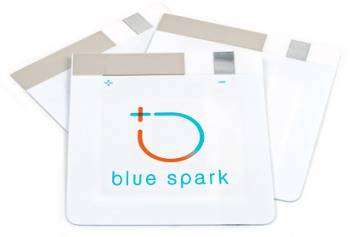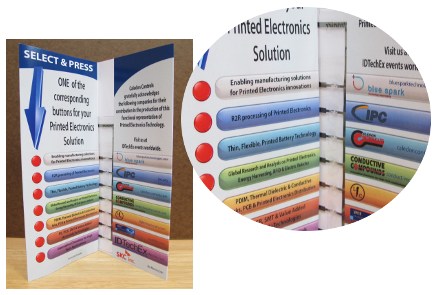 |
| April 10, 2012 | Volume 08 Issue 14 |
Designfax weekly eMagazine
Archives
Partners
Manufacturing Center
Product Spotlight
Modern Applications News
Metalworking Ideas For
Today's Job Shops
Tooling and Production
Strategies for large
metalworking plants
Printed electronics technology:
Operational and ready for prime time

Blue Spark Technologies' customizable 1.5-V carbon-zinc batteries provide a reliable, affordable, eco-friendly power source for numerous applications.
Applications span interactive and smart packaging, battery assisted RFID, RF sensor systems, and more – all powered by thin and flexible low-voltage batteries.
By Matt Ream, Blue Spark Technologies
While printed electronics technology has been in the development and testing stages for several years, it has now reached the point of operational readiness. Global acceptance is driving increased market demand, and commercialization of the technology is being fueled by a global network of solution providers engaged in developing practical and affordable applications for use in a host of industries. In fact, industry analysts forecast that the market potential for printed electronics will be USD $35 billion by 2018, and sales of thin-film and printed batteries as a power source are expected to exceed USD $5 billion by 2015.
Printed electronics can be described as the printing of electronic devices on common media such as paper, plastic, or textiles using traditional high-volume printing techniques, such as screen, offset, gravure, and flexographic printing. The process can incorporate one or more thin-profile electronic elements, such as programmable chips (ICs), sensors, antennas, RFID tags, LEDs, electro-conductive and color-changing electro-chromic inks. The functionality of the electronic elements is powered and activated by thin, flexible, eco-friendly carbon-zinc batteries, which are also printable in mass quantities in a roll-to-roll process.

Printed carbon-zinc batteries can be used to incorporate light and/or sound effects in consumer goods packaging, such as in a cookie box that can be transformed into a toy fire truck, complete with working siren.
Some high-value applications for printed electronics reside in "smart" packaging, interactive printed media, battery-assisted RFID, RF-enabled sensor and temperature monitoring systems, and smart cards.
Bringing power to packaging – and a whole lot more
Quite a number of printed electronics solutions have been tested and are ready to launch across a broad spectrum of industries, including consumer goods, retail packaging and merchandising, auto-ID and security, and other key markets. All of the following applications use low-cost, disposable printed batteries to provide a reliable low-voltage power source.
- Interactive and smart packaging, retail shelf signage and merchandising displays. CPG manufacturers can leverage the power of printed electronics at the retail level to promote brand awareness by attracting consumer attention and engagement at the point of sale. Examples include interactive shelf signage and merchandising displays that light up or speak to prospective buyers, or that provide additional information of value.
Printed carbon-zinc batteries can also be deployed to bring power to a wide range of interactive packaging applications. Incorporating light and/or sound effects in consumer goods packaging can make products stand out on the shelf and drive increases sales. One example is a cookie box that can be transformed into a toy fire truck, complete with sound effects, after the product is consumed. Another might be a frozen meal package offering a timing mechanism to indicate when it's done, or a scrolling set of recipes activated by a push button. Pharmaceutical manufacturers might opt to provide interactive packaging designed to ensure patient safety and compliance in taking their medications properly and on schedule.
For many of these applications, process integration can be simplified since the batteries can often be printed in-line with traditional package printing. According to NanoMarkets, applications for battery-powered packaging encompass: pharmaceutical compliance packaging, case-and-pallet freshness monitoring devices, and tamper-proof courier packages.
- Interactive printed media. Another potentially profitable market is high-volume interactive printed media for consumer products and social expression. Products such as musical and self-recorded greeting cards, interactive children's books, posters, gift boxes, special-effect CD covers, games, and trading cards – all of which can be programmed to interact with users via sight, sound, and touch – are expected to be very attractive targets for printed electronics in the consumer market. Innovative designers might also consider integrating battery-powered printed electronics into apparel and accessory items, such as T-shirts, baseball caps, and backpacks. And direct mail advertisers and magazine publishers can create consumer or business-to-business "buzz" with more compelling interactive printed pieces.
- Battery-assisted passive (BAP) RFID. Sometimes called semi-passive, BAP RFID can significantly extend the capabilities RFID tags without incurring the higher cost of active RFID. The boost provided by the battery improves read ranges and tag readability – especially with RFID-unfriendly materials such as liquids and metals, or where individual tagged items are densely packed or stacked. BAP RFID systems can also provide greater memory and data security, making them a high-value choice for inventory and asset tracking of raw materials, finished goods, irreplaceable files, valuable tools and equipment, and the like.
- RF-enabled sensors and monitoring systems. These portable systems are becoming increasingly popular with manufacturers and distributors of food, pharmaceuticals, chemicals, and other temperature-sensitive goods. Thin, flexible printed batteries can be deployed to activate time-and-temperature monitoring systems to ensure cold-chain temperature compliance of perishable goods from the point of origin to points of delivery. Such systems could also be designed and programmed to monitor vibration, humidity, or other ambient conditions critical to product safety and quality.
- Powered smart cards. Today, there are about four billion plastic smart cards containing programmable chips being produced annually worldwide. Driving this growth is the need for increased security and authentication, as well as growing acceptance of contactless payments and consumer preference for wallet-size cards that integrate visual, interactive, and tactile innovations. Battery-powered cards enable card companies to incorporate lighted or color-changing displays, stored value and account status information, authentication codes (such as one-time passwords), and other interactive functions.
- Self-care healthcare and cosmetic applications. Also gaining traction in the marketplace are various battery-powered transdermal patches designed for self-administered delivery of over-the-counter medications used for smoking cessation, pain relief, or wrinkle reduction.
Low-cost disposable batteries: A key component
All of these printed electronics applications require a reliable power source capable of activating the other components, and that's where the printable low-voltage, carbon-zinc batteries come in. The batteries are typically printed on a recyclable plastic PET base using carbon, zinc, and manganese dioxide materials. The anode material may either be a laminate of zinc foil or printed zinc and the cathode material is a manganese dioxide mixed with carbon. After a separator is placed atop the printed design, a couple of drops of electrolyte are added, and a top layer of PET is used to seal the battery cell. Power generation in the battery results from a chemical reaction between the electrolyte liquid and the anode and cathode materials.

Blue Spark was a key contributor to an interactive printed media demonstrator distributed to all attendees at the IDTechEx Printed Electronics Europe 2012 conference and exhibition held April 3-4 in Berlin. Working with Caledon Controls of Canada and other component suppliers, Blue Spark provided its carbon-zinc batteries as a primary power source to activate LED lights in the promo piece.
The batteries are produced using high-speed, roll-to-roll printing processes, which means they can be prototyped and mass-produced quickly and economically. This scalability makes it possible to achieve economies of scale as product development advances from pilot test quantities to high-speed, high-volume production.
In use, printed batteries function as primary power cells. For product designers of low-voltage electronic products and systems, the 1.5-V printed batteries offer multiple advantages over traditional button and coin cells. These include:
- Eco-friendly, safely disposable. Unlike traditional batteries, printed carbon-zinc batteries are completely "green," containing no lithium, mercury, or other toxic materials. This is becoming increasingly important as the quantity of electronic devices on our planet continues to grow and global environmental regulations become ever-more stringent.
- Small form factor, thin profile, customizable shapes. Printed carbon-zinc batteries range from about 430 to 700 microns (0.017 to 0.027 in.) thick and are typically capable of delivering peak drain currents of at least 1 mA. Batteries supporting higher drain currents, and designs with voltages above 1.5V, can also be supplied. They can be used in applications where conventional batteries just won't fit or where integration of a conventional battery would be too complex and costly. Within limits, users can typically specify size and shape (linear and non-linear), overall voltage, storage capacity, and thickness – all tailored to the application requirements.
- Lower production and integration costs. Because they are made using conventional printing processes, thin printed batteries are typically less costly and faster to produce. The battery can often be printed or mounted on the same substrate as other printed electronics (IC chip, RFID inlay/antenna), so assembly and integration of the electronic elements into products is also faster, easier, and less expensive.
The question often arises on how printed carbon-zinc batteries compare to low-voltage coin and button cells from a cost, price, and performance basis. For applications such as smart cards and BAP RFID, it's simple, because coin and button cells just won't fit within these form factors. The size, thin profile, and flexibility of printed batteries make them the obvious choice.
In other applications, cost is a primary factor. Coin and button cells are mature in their product lifecycle, and low-price options are available. However, in evaluating battery options, designers need to consider not only the battery cost, but also the total cost of integration with the product. With coin cells, the additional costs related to purchasing retaining clip/holders, soldering the battery to a rigid circuit board, and insertion of the battery must be considered. These factors can increase total cost up to several times the price of the coin or button battery alone.
In addition, the relative ease of integrating printed batteries into products allows for higher levels of automated production. And, in some cases, integration costs can be further reduced by printing the battery on a shared substrate with other electronics, such as displays, ICs, and RFID inlays.
Innovation and business value
According to many analysts, printed electronics technology is set to revolutionize major segments of the electronics industry, and low-cost disposable batteries are essential to this transformation. Speed of adoption is increasing, thanks largely to alliances formed by leading developers of electronic devices who are working together to develop solutions that leverage the capabilities of printed electronics for business value.
The journey of printed electronics from research and development, to pilot testing, to operational readiness for mass production is now complete. As a result, we can all look forward to OEMs and their design engineers creating and launching an array of exciting new products and systems designed for consumer, industrial, financial, security, healthcare, and other markets.
About the author
Matt Ream is vice president of marketing for Blue Spark Technologies, a leading developer of flexible, eco-friendly proprietary power source solutions for battery-powered printed electronic systems. As an electronics engineer, Ream has 20 years of experience in high-tech electronics and radio frequency identification (RFID) and has held senior positions in engineering, product research and development, and marketing.
For more information, visit www.bluesparktechnologies.com or call 1-440-249-5400.
Published April 2012
Rate this article
View our terms of use and privacy policy
